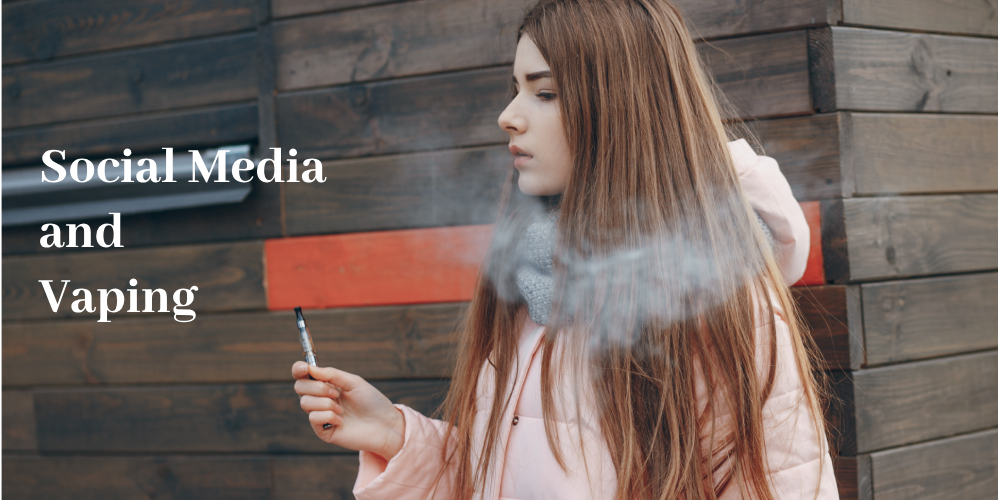
The Role of Social Media in Teens Vaping
Picture this: a teenager casually scrolling through Instagram, instantly captivated by colorful images of sleek vape devices and dense clouds of flavored vapor. Over on TikTok, videos showcasing impressive vaping tricks set to catchy tunes dominate the feed. Tweets glorifying the latest vape flavors pop up incessantly. Social media, a powerful tool for connection and communication, has also become a major influence on the rise of vaping among teens. Alarmingly, a 2021 study by the National Institute on Drug Abuse (NIDA) revealed that nearly one in five high school students reported vaping in the past month. This blog dives deep into the complex relationship between social media and teen vaping trends, exploring how these platforms fuel vaping culture and what can be done to counter their impact.
The Influence of Social Media on Teen’s Behavior
Social media platforms like Instagram, TikTok, Snapchat, and YouTube have transformed how teens interact, access information, and form their identities. For many teenagers, these platforms are integral to their daily lives, shaping their perceptions and behaviors. The algorithms that drive social media are designed to maximize engagement, often pushing content that is visually appealing and easily shareable characteristics that perfectly describe vaping-related content.
A study by the Truth Initiative found that 63% of young people who use social media reported seeing vaping-related content. This exposure can create a perception that vaping is a widespread, socially accepted, and even desirable activity. Peer influence, a critical factor in adolescent behavior, is amplified on social media, where teens are exposed to both their friend and influencer behaviors and endorsements.
How Vaping Content Spreads on Social Media
The spread of vaping content on social media is facilitated by several factors:
Influencer Endorsements: Influencers, with their massive followings, play a crucial role in normalizing and glamorizing vaping. They often post pictures and videos of themselves vaping, sometimes as part of sponsored content. This can make vaping appear trendy and attractive to impressionable teens who look up to these influencers.
User-Generated Content: Teens themselves contribute to the proliferation of vaping content by sharing their own experiences. This user-generated content includes everything from casual posts and stories to detailed vape trick tutorials and flavor reviews.
Targeted Advertising: Despite regulations, vape companies have found ways to advertise on social media, often targeting young users. These ads use colorful imagery, catchy slogans, and promises of flavors to entice potential young vapers.
Viral Challenges and Trends: Social media is known for its viral challenges and trends, and vaping has not been immune. Hashtags like #vapetricks and #cloudchasing have millions of posts, encouraging teens to participate in and share their vaping content.
The Impact of Instagram and TikTok
Two of the most influential platforms in the teen vaping trend are Instagram and TikTok. Instagram, with its emphasis on visual content, is a hotspot for vape-related posts. A 2019 study published in the journal “Tobacco Control” found that nearly half of the Instagram posts about Juul, a popular e-cigarette brand, were made by users under the age of 21. These posts often featured colorful Juul devices and young users exhaling clouds of vapor, creating a glamorous image of vaping.
TikTok, known for its short, engaging videos, has also played a significant role. The platform’s algorithm promotes viral content, and vape-related videos often gain substantial traction. In 2020, the hashtag #juulgang had millions of views, showcasing teens performing vape tricks or discussing their favorite flavors. This kind of content can quickly normalize vaping among young users and create a community around the behavior.
The Consequences of Social Media-Driven Vaping Trends
The normalization and glamorization of vaping on social media have serious consequences for teen health. Vaping is not a risk-free alternative to smoking; it carries its own set of dangers. The Centers for Disease Control and Prevention (CDC) reports that nicotine exposure during adolescence can harm brain development, leading to issues with learning, memory, and attention. Additionally, many vaping products contain harmful substances like heavy metals, volatile organic compounds, and cancer-causing chemicals.
Furthermore, the social acceptance of vaping facilitated by social media can lead to increased usage among teens. The 2021 National Youth Tobacco Survey found that 85% of youth e-cigarette users used flavored products, a preference heavily marketed on social media. This can result in a new generation addicted to nicotine, with all the associated health risks.
Strategies for Mitigating the Influence of Social Media on Teen Vaping
Addressing the influence of social media on teen vaping requires a multifaceted approach. Here are some strategies that can help us mitigate the impact
Education and Awareness Campaigns: Parents, schools, and health organizations need to educate teens about the risks of vaping. Social media could be a powerful tool for disseminating factual information and countering misinformation. Campaigns like the Truth Initiative’s “#ThisIsQuitting” use social media to provide support and resources for teens looking to quit vaping.
Regulation of Vaping Content: Social media platforms must take greater responsibility in regulating vaping content. This includes stricter enforcement of age restrictions for vaping-related content, removing promotional posts from influencers, and monitoring hashtags associated with vaping.
Parental Involvement: Parents play a critical role in guiding their children’s social media use. Open conversations about the dangers of vaping, monitoring social media activity, and setting boundaries can help reduce exposure to harmful content.
Support Networks: Creating support networks for teens who want to quit vaping can be incredibly effective. Peer support groups, counseling, and access to cessation programs can provide the necessary resources and encouragement.
Social media has undeniably played a significant role in the rise of vaping among teens. The allure of visually appealing content, influencer endorsements, and viral trends has normalized and glamorized vaping, leading many young individuals down a path fraught with health risks. However, by understanding the dynamics at play and implementing targeted strategies, we can mitigate the influence of social media and protect our youth from the dangers of vaping. It’s a collective effort that involves educators, parents, policymakers, and the teens themselves, working together to foster a healthier, safer environment. As we move forward, let’s leverage the power of social media to spread awareness, provide support, and ultimately, turn the tide against teen vaping.




